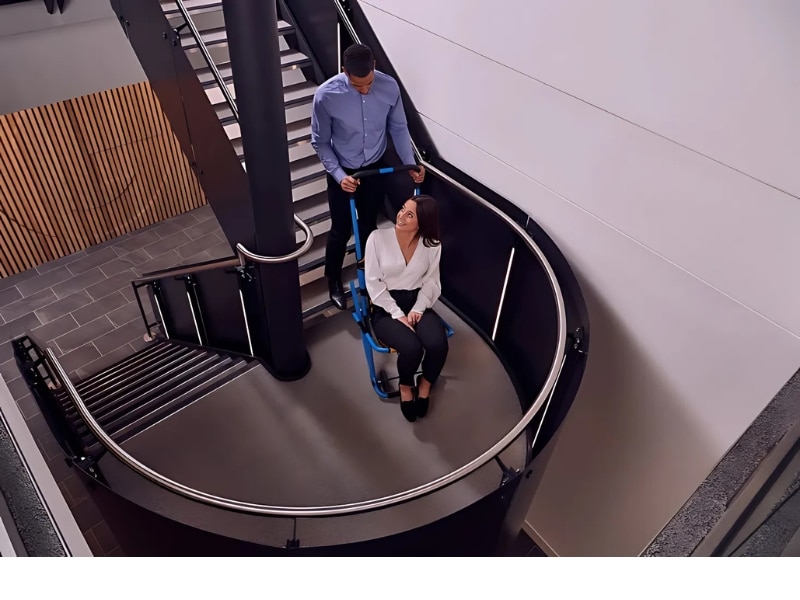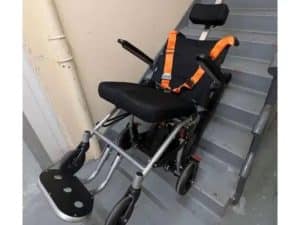Why are stair climbers essential for accessibility in multi-storey buildings?
Stair climbers are a game-changer for multi-storey buildings in improving accessibility. They provide an efficient, safe solution for individuals struggling with stairs due to mobility issues, heavy items, or emergencies.
- Increased safety: Stair climbers ensure individuals with mobility challenges can safely navigate stairs without the risk of falls.
- Independence: They help people maintain independence, allowing them to move around multi-storey buildings without assistance.
- Space-saving: Unlike lifts, stair climbers do not require much space or installation work, making them ideal for buildings with limited room for modifications.
- Quick deployment: Stair climbers are often portable and can be deployed quickly in emergencies, making them crucial for evacuation scenarios.
- Cost-effective: Installing a stair climber can be a more affordable option than installing lifts, especially in existing buildings where retrofitting lifts might not be feasible.
Stair climbers provide a practical solution for people with mobility challenges to navigate multi-storey buildings safely and efficiently, helping to enhance building accessibility for all individuals.
How do stair climbers compare to other accessibility solutions?
When considering accessibility options for multi-storey buildings, stair climbers often present advantages over other solutions, such as lifts and ramps.
Feature | Stair Climbers | Ramps | Elevators |
Installation required | No | Yes | Yes |
Cost | Low to Medium | Medium to High | High |
Portability | High | None | None |
Suitable for any building | Yes | Limited | Limited |
Usability during emergencies | Yes | Yes | No (power dependent) |
Stair climbers offer a flexible, cost-effective, and space-efficient alternative to traditional accessibility solutions, enhancing affordability and ease of use.
Is it safe to use stair climbers?
Manufacturers prioritise stair climbers’ safety. When used correctly, they offer a highly secure way for individuals to ascend or descend stairs.
- Stable and reliable design: Stair climbers are designed to remain stable on stairs, providing a secure means of transportation.
- Safety features: Many models have built-in safety features, such as seatbelts, anti-slip technology, and brakes, to prevent accidents.
- Low risk of injury: The design of stair climbers significantly reduces the risk of back injuries compared to other manual methods, such as carrying heavy loads upstairs.
- Training and support: Users can undergo training to ensure they are comfortable and knowledgeable in using the equipment safely.
- Emergency use: In emergencies, trained professionals can safely operate stair climbers to evacuate individuals who may not be able to use conventional methods.
Stair climbers are designed with safety in mind. They feature stability, safety mechanisms, and user training to ensure their safe use in various settings.
How do stair climbers help people with disabilities?
Stair climbers can be transformative for people with disabilities, enabling them to navigate stairs independently and safely.
- Improved independence: Stair climbers provide a sense of independence for individuals with mobility impairments, as they no longer need assistance to move between floors.
- Diverse range of users: Stair climbers can accommodate a range of mobility devices, including wheelchairs and walkers, allowing people with varying disabilities to use them.
- Support for caregivers: Stair climbers reduce the physical strain on caregivers by safely transporting individuals with disabilities up and down stairs without heavy lifting.
- Customisable solutions: Various stair climbers are available and can be tailored to specific needs, whether for personal use or in professional settings such as aged care or healthcare facilities.
- Access to public buildings: Stair climbers make it easier for people with disabilities to access public buildings without lifts or ramps.
Stair climbers help people with disabilities navigate stairs independently, enhancing mobility and reducing reliance on others for assistance.
Can stair climbers be used in all types of buildings?
Stair climbers are versatile and can be used in various building types, from residential homes to commercial and public buildings.
- Residential buildings: Stair climbers can easily be used in homes to help individuals with mobility challenges move between floors.
- Commercial buildings: Stair climbers make multi-storey spaces more accessible for both employees and customers in offices, shops, and restaurants.
- Public buildings: Stair climbers enhance accessibility by offering a cost-effective solution for improving mobility without extensive renovations in government buildings, schools, and healthcare facilities.
- Historical buildings: In older buildings where retrofitting a lift may be difficult due to space limitations or preservation requirements, stair climbers offer a practical alternative.
- Emergencies: Stair climbers can quickly evacuate people with mobility challenges safely in emergency evacuation scenarios, regardless of the building type.
Stair climbers adapt to most buildings, offering safe, efficient solutions for residential, commercial, historical, and emergency settings across various environments.
Who benefits most from stair climbers?
A diverse range of people and industries benefit from using stair climbers in multi-storey buildings.
- People with mobility challenges: Those who struggle with stairs due to age or disability can use stair climbers to move safely between floors.
- Aged care facilities: Caregivers can use stair climbers to transport residents with mobility issues, reducing the risk of injury for both parties.
- Healthcare professionals: In hospitals and clinics, staff can use stair climbers to move medical equipment and patients more efficiently.
- Logistics and delivery services: Stair climbers are beneficial for moving heavy loads between levels in logistics, removals, and retail businesses.
- Emergency services: First responders can use stair climbers to evacuate people safely during an emergency.
Understanding the benefits of specialised stair climbers for individual mobility can help individuals with mobility challenges, healthcare, logistics, and emergency services professionals who need to move people or equipment quickly and safely.
What makes stair climbers more efficient than traditional methods?
Stair climbers offer significant efficiency advantages over traditional methods of moving people or goods upstairs.
Advantage | Key Feature | Effect |
Reduced effort | Lessen physical strain on the user | Easier transportation |
Time-saving | Speeds up movement between floors | More efficient use of time |
Ergonomically designed | Reduces injury and strain | Enhanced comfort |
Versatility | Moves personal goods to heavy equipment | Suitable for many tasks |
Increased productivity | Streamlines item or person movement | Boosts work efficiency |
Specialised stair climbers for mobility assistance improve efficiency by reducing physical effort, saving time, and increasing productivity when moving people or goods between levels in multi-storey buildings.
Conclusion
Stair climbers enhance accessibility in multi-storey buildings by providing a safe, efficient, cost-effective solution for people with mobility challenges, businesses, healthcare facilities, and emergency services. If you’re looking for a reliable, ergonomic solution for moving people or heavy items between floors. In that case, stair climbers are the way to go.
Looking for an easier way to navigate stairs? Discover how Stair Climbers can make the process smoother and safer for you.


